Canada’s new GH light-pollution laws
If you’re a greenhouse grower in Leamington or Kingsville, Ontario, and you run supplemental lighting at night, you already know about this: Come April 1, you’ll face steep fines for light pollution unless you: 1) shut off the lights after dark; or 2) install blackout curtains and keep them closed from one hour before sunset to one hour after sunrise.
I learned about this when I was asked to moderate a webinar March 8 for the ACT (Advancing Cultivation Technology) Summit. Growers and interested parties from all over tuned in to the 75-minute session that featured Ton Habraken from Svensson, Paul Jense from Priva, and Dutch tomato grower Lars van Baar lending their expertise.
I suspect it could have been a bitching session on why the town councils had to make these rules; instead, we focused on how to grow in a greenhouse at night, under lights, when a curtain is holding in all that heat and humidity, which can negatively impact the crop.

One of the best solutions is “gapping,” or opening the curtain a small percentage (5% to 10%) during the night to vent the heat and humidity. That's what you see in the image above: a fully open curtain, left; a gapped curtain, center; and a closed curtain, right. Most rules, such as those that have been in effect in the Netherlands for about a decade, allow a few hours of gapping during the night. The Leamington bylaw allows for 10% gapping between 2:00 and 6:00 a.m.; the Kingsville bylaw requires 100% abatement all night long with no gapping.
Most of you are not Kingsville or Leamington growers, but if you grow with supplemental lights at night, these rules could affect your greenhouse, no matter how rural. Just ask Henry Huntington of lēf farm in Louden, New Hampshire, who dealt with it in 2018. I have heard that British Columbia and Quebec may be considering similar bylaws. You can be sure that if there's a glow in the sky, neighbors are complaining about it.
You can watch the whole session HERE.

In memoriam: Ramsey Yoder
March 2 marked the passing of an industry icon: G. Ramsey Yoder, the chairman and leader of Aris Horticulture (formerly Yoder Brothers until the company sold its Yoder mum business and changed names in 2008) passed away from complications related to pneumonia at the age of 87. Ramsey served as president of the family business starting in 1977, then CEO and Chairman of the Board in 1989. He retired as CEO in 1992, but remained Chairman. Although the pandemic disrupted daily routines, Ramsey stayed engaged and productive until just recently, the company said.

Ramsey, the grandson of company co-founder Menno Yoder, a Mennonite, added a strong education to his farm upbringing, graduating from Cornell with a BS in Floriculture in 1955 and completed the Small Business Owners Management Program at Harvard Business School. He joined Yoder Brothers in 1955 as a mum propagator at the Barberton greenhouses and was promoted to management in 1959 when he transferred to California to develop the Salinas operation, where he remained as General Manager for 10 years before coming back to Barberton to continue his leadership of the company.
It had been quite a while since I’d had the pleasure to speak with Ramsey. But one of my favorite discussions was for a “Behind the Business” on the beginning of the Yoder business (which had nothing to do with mums). You can read that fascinating journey back in time HERE.

Where spring has sprung, it has sprung hard!
I enjoy getting random text messages from my good friend and fellow International Garden Center Association traveler Tom Birt of Mesquite Valley Growers Nursery in Tucson. Wrote Tom most recently:
“If you don’t believe that money grows on trees, you haven’t been to a good garden center lately. It’s like printing money.”
I asked him to elaborate.
“We are 40% ahead of last year," he answered. "This is crazy. First million-dollar February ever!”
Which made me think: While those of us up north are speculating about how this season might go, those of you in the sunbelt are already experiencing it. So I emailed my favorite Florida garden center owner, Theresa Riley of Rockledge Gardens on the state’s Space Coast.
Replied Theresa, “We are doing great as well! February sales were up 37%! We are blown away.”
How about you? If spring has sprung where you are, what’s it look like? Let me know HERE.
Tom left me this last note to share with you:
“Do not fear raising prices. Nobody noticed how much we raised them.”

Potted plants: hortistician Marvin on “the rest of the story …”
When the post office gets your March GrowerTalks to you and you get around to cracking it open, you'll see that our resident hortistician, Marvin Miller, wrote up the information we might all glean from the recently released 2019 Census of Horticultural Specialties.
Marvin’s challenge for the readers was to compare what you're producing with the national averages for each crop to see if you're in tune with the industry as a whole and just to check whether you might be missing some opportunities. Conversely, there could be further justification for the niche you're occupying by not producing the big crops in any industry segment.
As I thought about this challenge, I thought there could be an opportunity to dig a little deeper into the crop categories to see what hidden information might be lurking. So I asked Marvin to explain “the rest of the story” for potted flowering plants, since this industry segment reported the largest growth—10.7% in dollars—between the 2014 and 2019 censuses (cenci?).
In Marvin’s GrowerTalks article, he details the dollar sales of the potted flowering plants that achieved at least $20 million in sales. You know, the big boys: poinsettias, phalaenopsis orchids, other orchids (dendrobium, oncidiinae and others), potted spring flowering bulbs (tulips, hyacinths, daffodils, crocus and others), combination planters, hydrangeas, hibiscus, potted mums, Easter lilies, begonias, florist potted roses, and other lilies. Each of these contributed at least 2% of the segment’s total sales dollars.
But there were quite a few important potted flowering plants in the census that didn’t get mentioned because they had smaller reported sales levels. Included in this list, in order of sales, were a number of notables like finished florist azaleas, gardenias, kalanchoe, Gerbera daisy, anthurium and cyclamen. Each of these contributed about 1% of the total value of the potted flowering plant segment.
 Kalanchoe wasn't even worthy of a mention? I thought lots of them were being grown!
Kalanchoe wasn't even worthy of a mention? I thought lots of them were being grown!
Falling below these were a number of other good potted crops that either provide niches for notable industry operations (as in African violets and Holtkamp’s) or where a lot of folks grow a few pots of each, such as zygocactus (schlumbergia), sunflower (over 300 operations reported some sales here), regal pelargonium (another case of more than 300 operations producing this), primula and alstroemeria. Each one of these crops accounted for less than a half percent of the total segment’s sales, but at least 0.1% of the total.
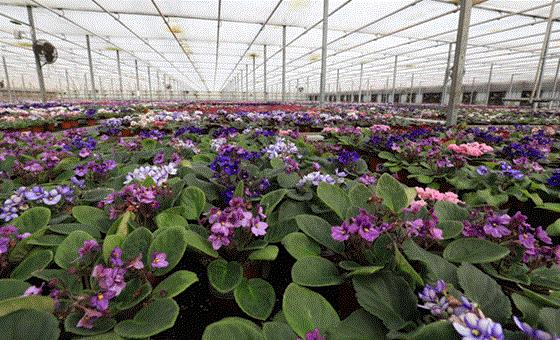
Don't tell Reinhold Holtkamp that African violets are a minor potted crop!
Even farther down the list were a handful of others where total sales didn't even round to 0.1% of total segment sales. Included here are cineraria, exacum, bromeliad, gloxinia and cape primrose (streptocarpus). After all of these 35 separately enumerated potted flowering plant crops, USDA reported that all other potted flowering plants still accounted for 18.1% of total sales in this industry segment.

Today’s potted plants compared to 1970
Knowing Marvin never throws away a piece of paper, we asked him how much the potted crops in today’s census look like those grown 50 years ago. This proved fascinating. The only classes that were in that 1970 survey that aren't in the most recent survey were calceolaria, Christmas cherry and Christmas pepper, Marvin says. That survey also included fuchsia (which has since been moved to the bedding/garden plant segment), and cacti and succulents (which has been moved to the foliage plant segment).
So what crops might be on that mysterious list of 18.1% of potted plants classified as “other”? Marvin suggested that a tour through the potted plant sections of various catalogs would yield a list that would include campanula, celosia, lisianthus and ranunculus. He also noted that over the years he's seen some bedding plants used as potted plants: pots of calendula, crossandra, dianthus, gomphrena, ornamental oregano, osteospermum, torenia and zinnias have all donned foil and bows on occasion—although some may wear these accoutrements better than others!

Exacum was the first potted crop mentioned in the first GrowerTalks of May 1937. Just below it, George Ball himself wrote, "A committee of National Flower Show judges at Milwaukee ruled out ... a 99% perfect entry of double petunias on the goround that they could not be classified as bedding plants! True, they are ideal as pot plant—so are geraniums and coleus."
How about you? Do you grow any of these less-common potted flowering plants or any not listed here? Maybe some double petunias? Tell me about it HERE and include some pix.
Me, I loved offering glox and exacum on a weekly basis to my florist customers. But I had the luxury of buying from Earl J. Small and getting those paper-wrapped liners in the Styrofoam cooler—remember those days?
(BTW, why do we call them potted plants and not pot plants? No, it's not for the reason you think. It's because you don't call them "can peas.")

Upcoming webinars: Hostas, Integrated Environmental Controls
I’ve got two more webinars on the docket that “will do you good and help you, too” as my late father-in-law was fond of saying. They are:
Surround Yourself with Shady Characters: Modern Hosta Hybridizing, Introductions & Practical Production Tips
TODAY Wednesday, March 10, 1:00 p.m. Eastern/noon Central
Hostas are a mainstay of shade gardens and regularly rank among the most popular perennials in production today, and that popularity shows no sign of going anywhere but up. If you want to know what’s new in the world of hostas or get some culture tips to boost your production, this is the webinar for you! Leading off this webinar is Hans Hansen, Walters Gardens’ resident plant expert extraordinaire. Hans has been hybridizing and working with hostas for more than 30 years, and in this presentation, he’ll share his experience with the popular perennial and the traits he looks for when breeding and selecting new hostas.
Joining Hans is avid hosta enthusiast Laura Robles, regional product manager for Walters Gardens. Laura will cover the best cultural practices for growing hostas.
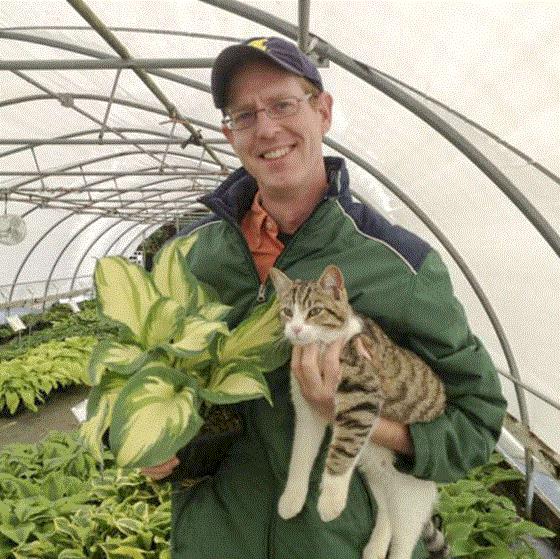 Hans the breeder with "Hans" the hosta and Jasper the cat.
Hans the breeder with "Hans" the hosta and Jasper the cat.
The Value of Fully Integrated Control Systems in the Greenhouse
Thursday, March 25, 1:00 p.m. Eastern/noon Central
In this webinar, Jeff Woolsey from Woolsey Consulting, LLC will share his insights and 35 years of experience in the horticultural industry (including with key players like Metrolina Greenhouses) to address the relationship between using fully integrated control solutions and key concepts for greenhouse operations, such as return on investment, plant quality, efficient use of resources and product tracking.
Sign up for either or both at www.growertalks.com/webinars.

Meet the latest EAGL class
My friend and yours, Dr. Charlie Hall (the Ellison Chair for International Floriculture at Texas A&M)) is proud to announce the graduation of the eighth cohort of his elite “Executive Academy for Growth & Leadership” (EAGL) program for nursery and greenhouse growers. The “Iota” class of seven industry leaders received their Certificate in Applied Horticultural Business Management from TAMU on February 4 despite the challenges of the pandemic.
COVID-19 forced this year’s class into a series of accommodations, including more intense Zoom-based sessions and physical distancing, testing, masks and outdoor environments when they could meet in person.
Faculty Lead and EAGL Founder Dr. Hall comments, "I am very proud of the work that this year’s cohort put into the planning efforts for their businesses and the innovative thinking that was generated in our meetings. This was a diverse group from several different types and sizes of growing operations that sold into diverse retail venues, so there was a lot of ‘outside-the-box’ sharing and insights that were generated.”
This year’s class (or “cohort” as it’s called) included:
Alan Jones, Manor View Farms, Maryland
Andy Aiken, Grower Direct Farms, Connecticut and Maine
Becky Thomas, Spring Grove Nursery, Illinois
Bob Blew, Centerton Nursery, New Jersey
Farai Madziva, Kitayama Bros Farms, California
Karin Walters, Walters Gardens, Michigan
Ryan Hop, Walters Gardens, Michigan.
Projects were judged by W.J. Rossi of Koss Olinger Financial and Ed Bales of Motorola University (retired).
The ninth group—the Kappa cohort—is currently accepting applications, but just three seats remain, so act quickly. Curriculum begins in June. To learn more about the curriculum, visit www.eaglnetwork.com.
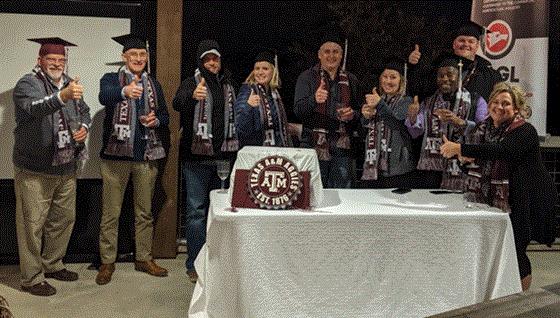 The Executive Academy for Growth & Leadership (EAGL) Iota cohort received certifications on February 4 in Dripping Springs, Texas. (L to R): Dr. Charlie Hall (faculty), Alan Jones, Ryan Hop, Karin Walters, Andy Aiken, Becky Thomas, Farai Madziva, Bob Blew and Kellee O’Reilly (faculty).
The Executive Academy for Growth & Leadership (EAGL) Iota cohort received certifications on February 4 in Dripping Springs, Texas. (L to R): Dr. Charlie Hall (faculty), Alan Jones, Ryan Hop, Karin Walters, Andy Aiken, Becky Thomas, Farai Madziva, Bob Blew and Kellee O’Reilly (faculty).

New varieties from TPIE
This is another case of stuff we would have seen at the winter trade shows had there been any winter trade shows … but there weren’t. TPIE—the Tropical Plant International Exhibition—did a great job offering online inspiration through their annual Cool Product Award, coordinated with Danny Summers and the Garden Center Group. Usually I do a video of the winners; this time, you’ll have to be content with me sharing five of my favorites, selected from the 14 Cool Product award-winners. I picked these because they’re tropical plants and you want tropical plants!
Mandevilla Sun Parasol Sunbeam (Suntory Flowers). Sun Parasol Sunbeam is the first yellow in the Sun Parasol brand. Blooms are a rich buttery yellow with a darker throat. Plants have a bushy habit that’s ideal for sunny containers and hanging baskets.
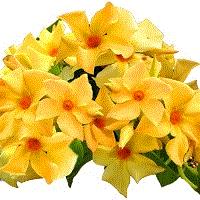
Hollywood Hibiscus Earth Angel (J. Berry Nursery) is a pure white addition to the Hollywood Hibiscus Collection, which is noted for exceptional bud and bloom counts, long-day lasting blooms, naturally well-branched habits and bacterial leaf spot and white fly resistance.

Colorful Classic Cannas (Abbott-Ipco). Traditional vegetative cannas are great … except for all those nasty viruses they typically carry. Abbott-Ipco is doing something about that by selling only rhizomes derived from virus-tested tissue culture plants. Classic Cannas’ eight colors will thrive in all heat climates and will rebloom spring through fall.
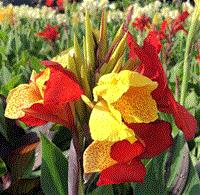

... and two more
Aglaonema Ultra Pink (Costa Farms). Ultra Pink is sure to capture consumers’ hearts with its bold, year-round color. Each red-pink leaf is edged in a band of rich green, making it as delightful to view up close as it is from a distance. It grows in virtually any home or office setting. adding a touch of life, a bold stroke of color and a lot of year-round beauty. This aglaonema is being introduced in a 6-in. ceramic pot as part of Costa Farms’ “Trending Tropicals” collection.
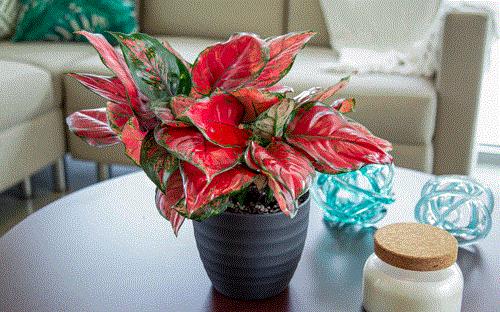
Artisan Collection (Urban Jungle). This Cool Product winner spoke to me because Laurie and I have long collected (and grown in) terracotta pots—something that’s getting harder and harder to find. Which is why I’m glad Bisser Georgiev and his designers have brought them back in this new in-house created form featuring traditional houseplants.

Next week, a few machines I would have seen at IPM Essen, had there been an IPM Essen. Which there wasn’t. But next year for sure!
National Plant a Flower Day is March 12
I’m not sure who dubbed it that, but hey, any excuse to promote flower buying and planting is a good excuse!

Interestingly, when this item came across my desk a couple of weeks ago, it was about 10F out with a foot of snow on the ground, and I thought, “Plant a flower on March 12? Dare to dream—at least in Chicagoland!” Well, spring has reared its lovely head, the temps have been in the 50s and 60s, the snow is gone other than a few dirty piles here and there, and the thought of a big pot of violas or bulbs by the front door seems achievable and not ludicrous. Count me in (provided I can find somebody selling flowers this early)!
Welcome to the Jungle (at Greenscape Gardens)
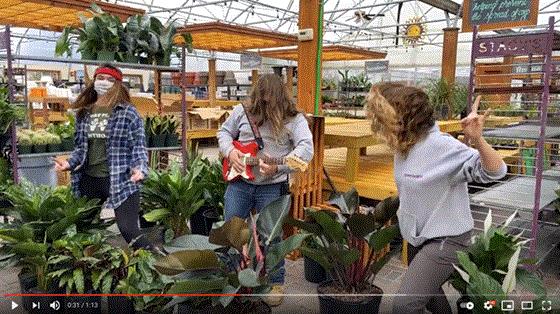
I like it when greenhouse businesses make quirky music videos promoting themselves. Such as this one by Greenscape Gardens of Manchester, Missouri, which took Guns N’ Roses’ famous tune and had some fun with it. Check it out HERE.
And while you’re at it, watch some of their other videos and help ‘em get their views up. These are good-quality videos, nicely shot and edited, and Zach and Anna are good presenters.
Finally ...
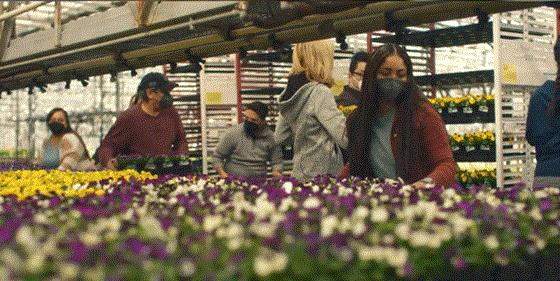
THIS will be the most-viewed horticulture video of all time. I say that with confidence, as it’s a 30-second Walmart commercial featuring our friends at Metrolina Greenhouses. It’s part of their “America at Work” initiative and the premise is buying American-made products enables more jobs for Americans. I saw it during “60 Minutes” last Sunday, along with 9 million other viewers, and folks I know report seeing it all over the dial, so it’s not just airing in niche DIY markets. A strong message and it’s great to see our stuff setting such a good example. Congrats, guys!
See you next time!

Chris Beytes
Editor
GrowerTalks and Green Profit
This e-mail received by 22,171 loyal readers!
Thanks to my loyal sponsors, who help me reach the 22,171 readers of Acres Online in 66 countries. Want to be one of them (a sponsor, that is)? Give Paul Black a shout and he'll hook you up.